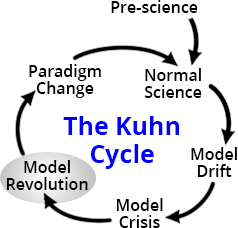The [[Kuhn Cycle]], also known as the life cycle of [[Thomas Kuhn]]'s paradigm shifting dynamics, is a concept proposed by Thomas Kuhn in his book "The Structure of Scientific Revolutions." It describes the process through which scientific paradigms evolve and change over time.
According to Kuhn, scientific knowledge does not progress linearly but rather undergoes periods of stability (normal science) interrupted by revolutionary shifts (paradigm shifts). The Kuhn Cycle consists of five main stages:

The original image is from [[@ModelRevolutionStep|The Model Revolution Step of the (Thomas) Kuhn Cycle]].
1. Pre-paradigmatic Stage: This stage is characterized by a lack of consensus among scientists regarding fundamental theories and approaches. Different schools of thought exist, each advocating for its own set of theories and methodologies. Research during this stage is often fragmented and lacks a unified framework.
2. Normal Science: A paradigm establishes itself as dominant, providing scientists with a shared framework for research. Normal science focuses on solving puzzles within the existing paradigm, following established rules and methodologies. Scientists work within the boundaries set by the paradigm, aiming to refine and extend its theories.
3. Anomalies: Over time, accumulating anomalies arise that cannot be adequately explained or resolved within the existing paradigm. These anomalies challenge the prevailing theories and create tensions within the scientific community. Scientists may attempt to explain these anomalies using ad hoc modifications or adjustments to the existing paradigm.
4. Crisis and Paradigm Shift: When anomalies become too numerous or significant to ignore, they lead to a crisis within normal science. This crisis opens up space for new ideas and alternative paradigms to gain attention. Eventually, a new paradigm emerges that provides a more comprehensive explanation for both existing phenomena and previously unexplained anomalies.
The transition from one paradigm to another is not immediate but involves resistance from scientists deeply invested in the old paradigm. However, as more evidence supports the new paradigm's superiority in explaining observed phenomena, it gradually gains acceptance among scientists until it becomes the new normal science.
# Dining Philosopher's Five Participants
By design or by coincidence, it is necessary to note that the [[Dining Philosophers]]'s problems often start with five participants sitting in a circular arrangement like Kuhn Cycle's five stages.
The Kuhn Cycle highlights the non-linear nature of scientific progress and emphasizes that scientific revolutions occur when a new paradigm emerges, fundamentally changing the way scientists understand and approach their field of study.
# References
```dataview
Table title as Title, authors as Authors
where contains(subject, "Kuhn Cycle") or contains(subject, "Bott Periodicity") or contains(subject, "DevOps")
```